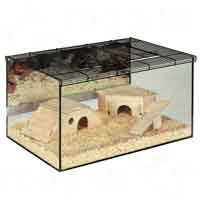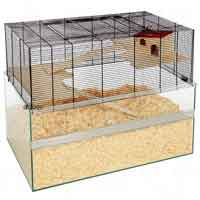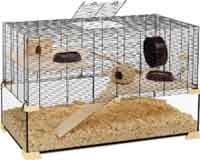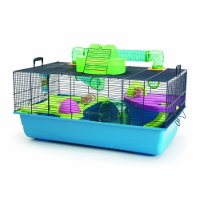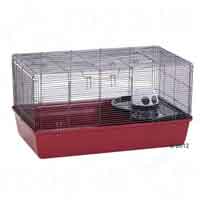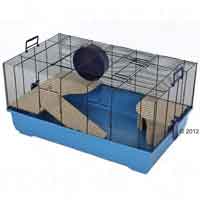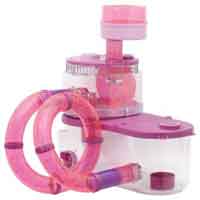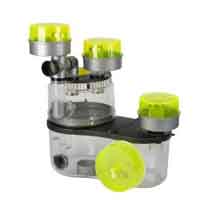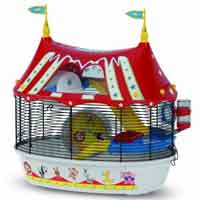Hamster Cages HQ saving you time, money & effort

The price of hamster cages can vary greatly between different sellers and you'll save money if you shop around before buying your cage. But visiting loads of websites to check the price of a particular hamster cage is time-consuming and can be very frustrating.
Whether you're looking for glass hamster cages, wire hamster cages, plastic modular hamster cages, dwarf hamster cages, or Syrian hamster cages Hamster Cages HQ will help you compare prices making sure you don't pay over the odds.
We regularly check the prices of the most popular brands of hamster cages so you don't have to. If you're in the market for a hamster cage it'll take you 2 minutes to easily find the best price and save time & money!
Popular Glass Hamster Cages
Popular Wire Mesh Hamster Cages
Popular Modular Hamster Cages
What to consider when buying hamster cages
There are cages available to suit every budget and you don’t need to spend a fortune in order to keep a pet hamster. If you’d like some pointers that may help you choose from the huge number of options for hamster cages then please read on…
Different styles of hamster cages for different breeds
There are generally 5 popular breeds of hamster kept as pets in the UK:
- Chinese
- Syrian
- Dwarf Campbell Russian
- Dwarf Winter White Russian
- Roborovski (sometimes shortened to Robo)
When it comes to which hamster cages are suitable for which hamster breeds you’ll find the 3 main cage types (plastic base tray with metal bars; glass; plastic modular) all have their good and bad points. From a safety standpoint though i.e. what provides the best environment for your hamster, it's fairly straightforward — the larger the cage the better, especially if you’re thinking of going for a Syrian hamster as most adult Syrian hamsters will benefit from an 8 inch hamster wheel.
Selecting cages for dwarf hamsters
If you’re considering buying any of the dwarf hamster varieties there are a couple of things to bear in mind:
- If you’re thinking of going for a cage with bars the gap between the bars should be no wider than 1 cm. This is simply because dwarf hamsters (and obviously baby/young dwarf hamsters) are tiny particularly Roborovski hamsters which are the smallest of the dwarf breeds.
- Dwarf hamsters are great burrowers and providing a base depth of 5 – 7 cm will allow them to follow their natural instinct and get busy “underground”.
Wire mesh cages
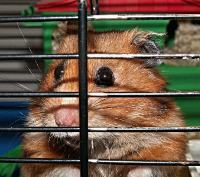
This type of cage is widely stocked by online retailers at a range of prices to suit most budgets.
If you just want to dip a toe in the water, and don’t want to spend a lot, there are plenty of options for buying something pretty modest and inexpensive. However there are also some absolutely fantastic cages around, that are definitely not modest or inexpensive, that will provide a really amazing environment for your hamster.
Generally these types of cage consist of a plastic tray on the bottom and a metal cage section on the top.
We think wire mesh hamster cages offer the best combination of price and size.
Examples of wire mesh hamster cages are the Alaska Hamster Cage by Zooplus, the Barney Hamster Cage also by Zooplus and the Bristol Small Animal Cage by Savic.
The metal sections can be of varying heights and attach to the plastic tray, usually by way of clips or catches, to keep the whole thing together as one complete and secure unit.
Often, these types of hamster cages come with free accessories such as a water bottle, food bowl, hamster house and hamster wheel. The free accessories aren’t always brilliant quality but it’s a starter for ten and they’re not expensive to replace.
The metal cage will usually have one or two doors in the side or top of the cage but preferably both.
Having both a top and side door is ideal if you have younger children as it can be a stretch for little arms to get to the bottom of a deep cage in order to pick up your hamster. The last thing you want to do is scare your hamster by awkwardly scrabbling around the bottom of the cage trying to pick him up — a frightened or agitated hamster is likely to nip. A side door gives you much easier access to food bowl, bottle, wheel, toys etc and of course your hamster.
Benefits of wire mesh cages
- Some plastic trays are pretty deep which means it'll hold a greater volume of substrate (the stuff that goes in the bottom of the hamster cage) which enables the hamster to burrow and play as it would in its natural environment — an example would be the Ferplast Favola Hamster and Mouse Cage .
- Plastic trays are strong, resilient to chewing, and very easy to clean.
- Metal bars are very useful for hanging toys and exercise equipment from — essentials to keep your hamster in peak physical condition.
- A hamster cage with bars ensures your hamster is always at room temperature due to having an adequate airflow. Be sure to make sure that your hamster cage is not in any kind of draught though.
- From a purely entertainment point of view a metal cage with bars gives a great view of your little furry friend and allows you to easily interact with your hamster without having to open up the cage to get your hand in or to get the hamster out.
Drawbacks of wire mesh cages
- Having bars for the main part of the cage may mean you end up with bedding and substrate outside of the cage.
Wire mesh cage costs
Prices continually change but wire mesh hamster cages can be bought online for prices ranging from around £39 to £65.
To get a good idea of prices check this list of hamster cagesavailable for sale in the UK.
Plastic modular cages
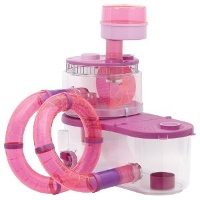
The plastic modular type of hamster cages usually come with a large collection of tunnels and pods in which your hamster can explore and play and provides umpteen places for a nice nest. These cages start at around £28 and increase in price depending on how elaborate you want your cage to be.
One of the drawbacks of plastic modular hamster cages is that they're usually on the small side — you can check out cage sizes and prices using our hamster cages price list. You should always try to give your hamster as much room as possible and the great thing about the plastic modular cages is that they can easily be extended.
Benefits of plastic modular cages
- Being modular they can be expanded very easily in order to give your hamster a larger environment in which to play and exercise. Providing new areas for your hamster to explore will provide stimulation as he goes exploring.
- Like the first type of cage, modular cages are often sold with accessories such as water bottles, food bowls and a wheel which can come in handy when just starting out.
- Modular cages can often have fairly deep bases which is excellent for hamsters that love to burrow.
Drawbacks of plastic modular cages
- The presence of so many small tunnels and pods can reduce ventilation and the flow of clean air through all sections of the cage
- The presence of small tunnels, pods and accessories can be rather fiddly and may turn cleaning into a bit of a chore.
- Lots of extra hiding places can make it tricky to see your hamster and make it more difficult to get him out when you want to clean out his cage.
- Lots of plastic bits can provide more opportunity for chewing so careful and frequent inspection of parts is required – you don’t want him escaping or swallowing loose bits of plastic.
Glass hamster cages and terrariums
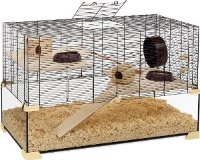
If you’re thinking more along the lines of glass hamster cages or terrariums for your hamster you’ll find them in lots of sizes and prices.
You’ll also find that some come with covers whilst some don’t. If you buy a glass tank that doesn’t come with a cover it’s important that you buy one or make your own. It’s also (obviously) critical that your hamster is safe from other household pets as well.
Hamsters are great climbers and in a shallow tank, if there’s exercise equipment and toys to climb on they’ll definitely make a bid for freedom.
If you’re not aware that your hamster has gone travelling it can be really hard to find him again.
Benefits of glass hamster cages
- One of the great things about a terrarium is the easy access you get to your hamster – no struggling through doorways that are only just bigger than your hand.
- If you’re thinking about getting a dwarf hamster then a glass cage can be ideal as there’s absolutely no way your hamster will be able to squeeze out the sides of it – not even if it’s Houdini Hamster.
- Being glass your hamster will never be able to chew on it either. Metal bars can be tempting for a hamster to bite which can be really noisy at night time which can often be rather annoying.
- A glass cage will also allow you to provide a really deep layer of substrate which will allow your hamster to get some serious burrowing action going on.
Drawbacks of glass hamster cages
- Glass terrarium s are usually much heavier than other types of cage. This means it can’t be lifted as easily as other types of cages. Also you’re going to find it hard to be able to give it a rinse under the tap.
- Having sides of glass means that the inside won’t always get the right amount of airflow. To help alleviate the problem you’ll need to make sure the top of the tank is covered by something that allows air to flow and at the same time keep the hamster in and other pets out.
Glass hamster cages with wire mesh — the best of both worlds
There are some places online that sell glass sided tanks with a wire mesh cage that sits on top which provides the best of both worlds. You get the deep substrate for super burrowing along with the easy access of a glass hamster cage and the security and great airflow of wire mesh. The Falco Small Pet Cage is a great example of this type of glass and wire mesh hybrid hamster cage.
Costs for glass hamster cages
If you’ve decided on glass you’ll find they’re not stocked as readily as other types of cage, and they’ll typically be dearer. Prices continually change but start from around £70 for the Small Pet Terrarium Kerry to £169 for the Living World Green Eco Habitat .
Read more about glass hamster cages and terrariums.
Summary of types of hamster cages
The following table gives you the main points to bear in mind when selecting hamster cages to buy:
| Cage Type | Benefits | Drawbacks | Approx Price |
|---|---|---|---|
| Wire mesh | Widely stocked; Suits most budgets; Wide range of sizes;Easy to clean; Good airflow; Good access to hamster | Can be messy as bedding & substrate etc can be pushed out through bars; Not all are suitable as a dwarf hamster cage | £39 — £65 |
| Plastic modular | Can be expanded very easily; Provide plenty of places for exploration & exercise; Can be suitable for dwarf hamsters | Smaller enclosed areas can reduce airflow; Can be time-consuming to clean; Access to hamster can be more limited; Not usually suitable as Syrian hamster cages | £28 — £40 |
| Glass hamster cages | Easy access & viewing of hamster; Suitable for dwarf and Syrian hamsters | May need to buy a separate cover; Can be heavy to move and therefore to clean; Can have reduced airflow | £70 — £169 |
Most popular manufacturers and sellers
As a bit of extra info here’s a list of the main specialist cage manufacturers:
- Ferplast
- Rotastak
- Savic
- Habitrail
- Harrisons
- Imac
- Zooplus
As a bit of extra info here’s a list of the main specialist cage manufacturers:
- Zooplus
- Pet Supermarket
- Pet Planet
- Amazon
- eBay
Hamster wheel safety
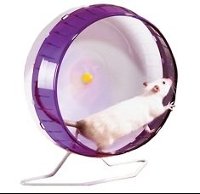
It’s really important to make sure that if you get a free hamster wheel with your cage it isn’t the sort that has rungs through which your hamster’s leg might fall through, get trapped and get broken. Most of the wheels that come with cages these days will be of a solid construction with no spaces between the rungs which is great and is the safest option.
It’s also important to make sure that the wheel in the cage is of a suitable size for your hamster. If your hamster has to bend his back in order to use his wheel then it’s too small and you need to buy a larger wheel. Replacement wheels can be had for around £5 — £20.
Final thoughts on hamster cages
If you’re looking for a hamster cage online you won’t go far wrong if you stick to the reputable sellers. The main online shops all have great selections of cages at a whole range of price points to suit most budgets.
If you’re going for a dwarf hamster cage then you could start out with one of the smaller cages, perhaps one of the modular types or a glass terrarium. The things to watch out for are the size of the bars, big gaps = escaped hamster, and depth allowed for substrate — the deeper the better as dwarf hamsters love to burrow.
If you’re going for a larger hamster such as a Syrian then go for a larger cage that will provide plenty of room to play and exercise. Most people seem to be agreed that the larger the cage is the happier the hamster will be so the larger plastic bottom and wire mesh types would be most suitable. If your space is limited you could always stack 2 cages one on top of the other and connect them to each other with tunnels.
Hamster resources
For more general hamster info please follow the links below:
Hamster cages for sale
Hamster cages by brand
-
Ferplast Hamster Cages
Circus Fun Hamster Cage * Favola Hamster and Mouse Cage * Hamster Tris * Karat 100 Glass Hamster Cage * Karat 60 Hamster and Mouse Glass Cage * Karat 80 Hamster and Mouse Glass Cage * Mini Duna Hamster Cage *
-
Habitrail Hamster Cages
Ovo Dwarf Hamster Habitat *
-
Hagen Hamster Cages
Living World Green Eco Habitat (S) * Living World Green Eco Habitat Large * Living World Green Eco Habitat Medium *
-
Imac Hamster Cages
Fantasy Hamster Cage *
-
Rosewood Hamster Cages
Rosewood PICO XL Hamster Cage *
-
Rotastak Hamster Cages
Creepy Castle * Genus 200 Hamster Cage * Pink Palace * Rotastak Maxi Mansion * Space Command Hamster Cage * Super Pod Hamster Cage *
-
Savic Hamster Cages
Hamster Heaven Cage * Savic Bristol Hamster Cage *
-
Skyline Hamster Cages
Falco Small Pet Cage - Large * Falco Small Pet Cage - Medium * Small Pet Terrarium Kerry *
-
Zooplus Hamster Cages
Alaska Hamster Cage * Barney Hamster Cage *
